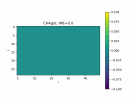zhipengpei
New member
Hi,
I have been trying to simulate a tracer plume for a idealize case with WRF-LES model. I have one domain with resolution of 300m. Simulating time is 6 hours. I was confused why the plume left the border and then re-entered the domain from another border (image below).

Actually, the easiest way to solve this problem is to increase the domain size so that the plume cannot reach the boundary (either by reducing the simulation time or by using a coarser resolution).
In addition, I was confused about the unit. For example, what is the rate of tracer release (I'm guessing 1 t/h?) and what are the units of simulated tracer (volume mixing ratio? )?
Appreciate for any help.
Thanks
Zhipeng Pei
I have been trying to simulate a tracer plume for a idealize case with WRF-LES model. I have one domain with resolution of 300m. Simulating time is 6 hours. I was confused why the plume left the border and then re-entered the domain from another border (image below).

Actually, the easiest way to solve this problem is to increase the domain size so that the plume cannot reach the boundary (either by reducing the simulation time or by using a coarser resolution).
In addition, I was confused about the unit. For example, what is the rate of tracer release (I'm guessing 1 t/h?) and what are the units of simulated tracer (volume mixing ratio? )?
Appreciate for any help.
Thanks
Zhipeng Pei



